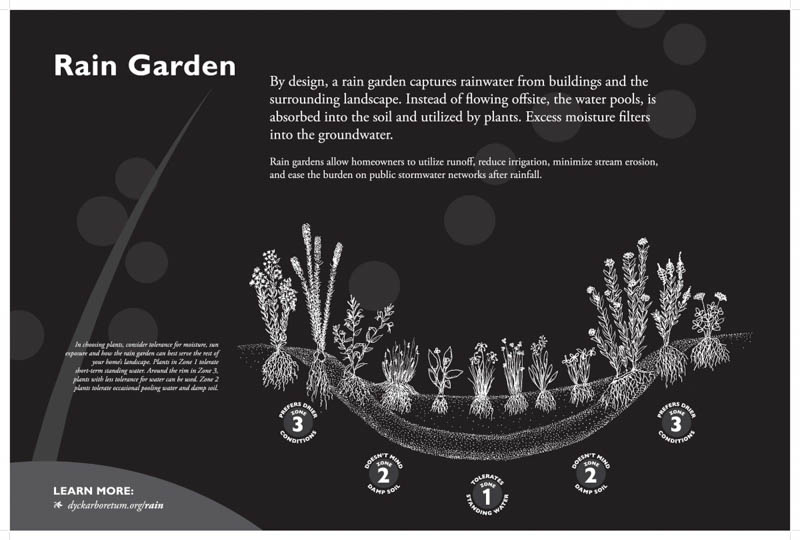
How do I create a rain garden?
It’s not complicated. Just follow these easy steps:
1. Determine the size of your rain garden by estimating your roof’s square footage. Your rain garden should be about one third the size of the area providing runoff. The 70-feetsquare gardens in this guide are based on a roof area of 200 square feet. If your roof area is smaller or larger, you will need to adjust the garden size accordingly.
2. Choose a spot at least 10 feet from your house and down slope from your downspout or sump-pump outlets.
3. Before digging, make sure you won’t encounter any utility lines. Contact (800) DIG-RITE so utility lines can be marked.
4. For a 200-square-foot roof area, dig a shallow depression 6-to-8 inches deep and 10-feet long by 7-feet wide. Slope the sides toward the center. Adjust the square-footage measurements if your roof area is larger or smaller.
5. Test the overflow pattern to be sure it runs away from your house. Do this by filling the depression with water and watching the overflow. If necessary, dig a shallow channel to direct water away from buildings and toward the street.
6. Direct your downspout or sump-pump outlet to your rain garden depression, either by digging a shallow channel or by piping runoff through a buried 4-inch, black plastic drainpipe.
7. Now you are ready to plant the native plants recommended in this design sheet. The designs place taller plants in the center of the design and shorter ones along the edges. Adjust plant numbers if your garden is larger or smaller.
8. Put a 3-inch layer of untreated shredded hardwood mulch on the bare soil around the plants to conserve moisture and keep your design looking neat.
9. Water your planting every other day for the first few weeks or until it shows growth and good establishment.
Plant Selection
In choosing plants, consider tolerance for wetness, sun exposure and how the rain garden will tie into the rest of your home’s landscape. Plants at the bottom of the rain garden (Zone 1) should tolerate short term water pooling and damper soils. Around the rim (Zone 3), plants with less tolerance for water can be used. Zone 2 plants should tolerate occasional standing water.
- Zone 1-for plants that can tolerate wetter conditions for several days
- Zone 2-for plants that can tolerate occasional standing water
- Zone 3-for plants that prefer drier conditions
Plant Suggestions
New England aster Aster novae-angliae
Purple prairie clover Dalea purpurea
Spotted Joe-Pye Eupatorium maculatum
Dogtooth Daisy Helenium autumnale
Torrey’s rush Juncus torreyi
Prairie blazing star Liatris pycnostachya
Cardinal flower Lobelia cardinalis
Great blue lobelia Lobelia siphilitica
Wild bergamot Monarda fistulosa
Mountain mint Pycanthemum virginianum
Green bulrush scirpus atrovirens
Stiff goldenrod Solidago rigida
Culver’s root Veronicastrum virginicum
Golden Alexander Zizia aurea
Sweet flag Acorus calamus
Red milkweed Asclepias incarnata
Water plantain Alisma subcordatum
Bottle brush sedge Carex hystricina
Fox sedge Carex vulpinoidea
Wild blue flag iris Iris virginica shrevei
Torrey’s rush Juncus torreyi
Cardinal flower Lobelia cardinalis
False dragon’s head Physostegia virginiana
Arrowhead Sagittaria latifolia
Green bulrush Scirpus atrovirens
River bulrush Scirpus fluviatilis
Soft-stemmed bulrush Scirpus validus
